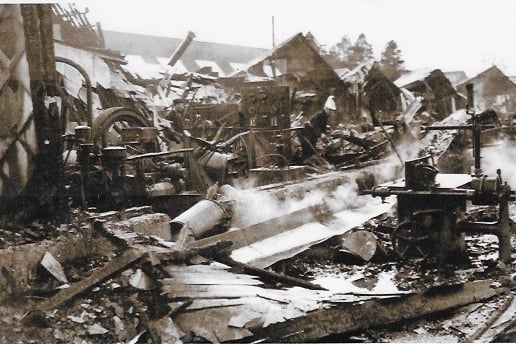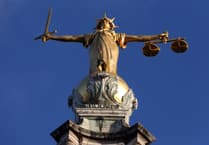A winter morning brought one of Farnham’s greatest dramas — the day Abbott’s coachworks went up in flames, writes Len Huff.
There are chores that belong to every working life, small rituals that bookend a week. At Abbott’s, Saturday, December 28, 1935, carried that familiar rhythm. It had been a good year. Edward Abbott had survived his takeover of Page & Hunt Ltd and the worst of the Great Depression, bodied the buses that first kept the firm afloat, and now looked ahead to firm orders. Aston Martin wanted 25 drophead coupés; Talbot and FN-BMW had confirmed commissions; more work was close on the horizon.
On Saturdays the men worked from 8am until noon. There was no fear of job losses in 1935, and overtime was there for the taking. As the hooter neared, benches were cleared, tools checked, bib-and-brace overalls bagged for washing. Dinner — never “lunch” — awaited, perhaps the bus into Farnham with wives and children. Christmas was over, school began again on Monday, January 6, and wages had been paid the day before.
In the Trimmers’ Shop, tidy came quickly — a last sweep, a breath of cold air, and out. The apprentices started at one end, sweeping under benches, pushing sawdust into generous piles. The routine hardly varied: sweep, tip the bin, flick away a cigarette end, then sweep again.
By then the yard was quiet. A few bicycles leaned in the shed; a mate had offered a lift home — or to the Cricketers Inn for a swift half. The last duty belonged to Mr Fred Hack, the boilerman and guardian of keys and switches. Lights out, plugs off at the wall, windows and doors secured, and finally the front gates. He lived round the corner and walked home, thoughts perhaps turning to the new year ahead.
But, in a metal bin in the carpenters’ shop, a cigarette end glowed hotter and hotter. Sawdust and shavings warmed to self-combustion.
At 5.30am on Monday, December 30, a neighbour woke to a reflection on the wall next door. At first he thought it was the newspaper train along the line beyond Weydon Lane, north of the factory — usually only a footplate’s orange wink showed in the dark. But this was different. The train seemed lit by a lurid glow; smoke from the chimney, normally white, shone red against the sky. Flames were less than fifty yards away.
“There was an explosion,” he said, “and the sparks flew into the air like a giant Roman candle.” The family dog tore round the house, wild with the crackling.
Mr W.E. Gardner, of the Farnham Riding Establishment opposite the works, met Mr Harry J.S. Croucher, Abbott’s chief engineer, and his son, Anthony, and they dashed across together. Croucher’s wife had already roused him — Monday was her wash day; she had heard the crackle. He grabbed an extinguisher, but, as he later told reporters, “we could do nothing; the place was like a furnace, full of smoke.” He phoned the Fire Brigade and told his wife to telephone Mr Abbott.
When the Farnham men arrived with two engines, Aldershot followed 20 minutes later. Croucher went with them as they smashed a door to reach the electricity supply. The site took a 2,000-volt feed, and shortly after 9am a generator was in place, lines run to safer buildings to give light for salvage should the wind change.
Explosions thudded through the morning. Gas bottles and cylinders beneath the Welding Shop’s lean-to blew, flinging burning timber more than 50 yards across Weydon Lane onto the railway bank, where wet winter growth kept the embers in check.
Broken asbestos tiles burst skyward, bright as fireworks, before falling back into the blaze. Cars were pushed clear of the Paint Shop to Gardner’s yard, while fifteen horses and ponies whinnied and shivered until calmed by his son Philip and the grooms. There was anxious talk of the 800 gallons of petrol in the underground tanks, but fortune, for once, sided with Farnham — the south-westerly wind blew the fire away from the showrooms, offices and pumps.
From River Row, young paper boy Albert Birmingham later said the light was so fierce you could almost read by it. Windows shook and broke as far as Yatesbury House; some thought it was Aldershot manoeuvres, others recalled the sounds of wartime raids over Guildford. For more than an hour the sky glowed red for miles.
Within two hours only the brickwork of the south and west walls remained. Inside lay wrecked machinery, burnt-out cars and charred timber; steel roof girders sagged, twisted by heat. A fireman said the flames “spread against the wind from the east to the west end,” running like a snake along the building.
The River Wey, in flood, provided most of the water — about 400 yards of hose were hauled up steep River Lane. The hydrant by the Cricketers Inn, with its downhill run, gave the best pressure.
Mercifully, no one was badly hurt, though several firemen suffered cuts and smoke inhalation. The “aero” workshop in the far north-east corner survived. Designer Jack Higton’s first-floor office at the west end, home to drawings and patterns, was spared, though the shop jigs were lost and had to be remade at once. About seventy craftsmen lost their personal tools. Machinery destroyed was valued at £4,000, overall damage at £20,000 — modest figures that still surprise historians.
Orders had been strong — Talbot 10s and Frazer-Nash bodies for imported BMW chassis — yet many cars were lost: an Austin police car, 22 Talbot 10s, Mr F.C. Redman the butcher’s delivery van, a unique 27hp Vauxhall Regent coupé with a mechanical roof valued at £700, and a 1923 Barker-bodied Rolls-Royce cabriolet. Another Daimler, and possibly a second Rolls-Royce, were lost, their models untraced.
Farnham’s finest answered with heart. Nineteen firemen under Chief Officer F. “Barry” Elderfield, Aldershot’s brigade under Second Officer C.J. Loveridge, Police Sergeants W.H. West and A. Bishop controlling traffic, and St John Ambulance volunteers treating cuts and fumes — Sergeant West himself was overcome and given oxygen.
For Edward Abbott, it was the longest Monday and the shortest night. By dawn, plans were already under way for recovery. In memory the blaze still roars, but so too does Farnham’s will to rebuild what the fire tried to destroy.
This is an edited extract from Len Huff’s book on ED Abbott. Email him on [email protected] for more information.





Comments
This article has no comments yet. Be the first to leave a comment.